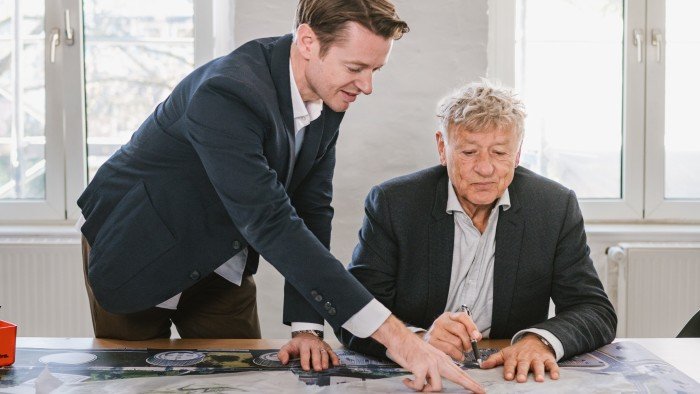Unlock the Editor’s Digest for free
Roula Khalaf, Editor of the FT, selects her favourite stories in this weekly newsletter.
Drivers like Lando Norris and Max Verstappen grab the headlines but track designers are the hidden hands shaping Formula 1’s future — and its image.
It has been a busy period for the small number of specialists in the field since Liberty Media bought F1 in an $8bn deal in 2017. The US group has transformed the sport, adding new circuits to the calendar as it expanded the season from 20 to 24 races in a push to tap new markets and boost revenue.
But the work has not all been about getting the straights and corners just right to create an exciting race to pull in the fans. The trackside infrastructure and the backdrop are equally important to the circuits’ owners as they seek to boost income by turning them into all-year round venues.
The expansion first focused on the Middle East with the number of Grand Prix in the region doubling in 2021 when Qatar and Saudi Arabia hosted their first races at new circuits in Doha and Jeddah, respectively.
This was followed by a tripling of the number of Grand Prix in Liberty Media’s home market, beginning with Miami in 2022 and Las Vegas the following year. Spain is due to host its second F1 race next season with the addition of Madrid, while Rwanda, South Africa and Thailand are possible future additions.
“It’s not only pure track and grandstands for people but it’s entertainment,” says 70-year-old Hermann Tilke, the leading designer over the last three decades, whose projects include tracks across Europe and recent city circuits, including Jeddah and Las Vegas.


Tilke and his son Carsten, who jointly runs Tilke Engineers & Architects with his father, point out that the shift from purely functional racetracks began under former F1 supremo Bernie Ecclestone, who brought Malaysia (no longer on the calendar) and Bahrain into F1.
As sport and entertainment blend together, it is not enough just to design a track for the drivers. F1 must cater to a fan base that is getting younger — as a result modern circuits are now doubling as backdrops for social media.
Hospitality facilities also have to be expanded to accommodate sponsors, corporate entertainment and the growing number of famous personalities attracted to the show.
Given the global reach of the sport and an estimated fan base of 750mn, there is also the challenge of building circuits for host nations that are conscious of shaping an image on the international stage, showcasing national landmarks and tourist destinations.
One of the key aspects of track design is how the race looks to the majority of people watching it on TV screens and other devices. Cutting-edge tracks and magnificent coastlines look good on television, says circuit designer Alexander Wurz, but “zoomed-out camera shots make a car going 350kph look reasonably slow”, adding: “You have to design the track to make the speed feel real.”
Wurz, twice winner of 24 Hours of Le Mans and a former F1 driver, also highlights a shift towards multipurpose motorsport venues that are in cities or closer to urban centres. “I’m convinced modern racetracks will become lifestyle centres . . . [fitting] perfectly into the urban environment” by offering lots of things to do to draw in locals as well as tourists, he says.


Wurz is working alongside Tilke Engineers on Qiddiya Speed Park Track, which will form part of a wider sports and entertainment complex in Qiddiya, south-west of Riyadh and is expected to become an F1 circuit later this decade.
For circuit owners, the real financial challenge begins when the chequered flag falls on their annual F1 Grand Prix. In a bid to secure an all-year round revenue stream from the track, designers are now looking to build venues that can host other motorsports competitions, offer conference facilities and attract hobbyists to race their own cars.
“These circuits are now becoming almost motorsport theme parks,” says John Rhodes, director of entertainment and sport at design and architecture group Hok, who previously led the redesign of Silverstone, host of this weekend’s British Grand Prix, in 2010 when he was at Populous. “The [F1] event itself is difficult to commercialise [for circuit owners]”.
It is not just new circuits that are keeping the designers busy. With the demand to join the calendar — F1 typically negotiates bigger fees from race promoters outside Europe — the pressure is on the legacy courses to ensure they are financially sustainable so that they can retain their place.
Silverstone, host of this weekend’s British Grand Prix, has invested to create a festival feel that includes live music and nightclubs, as well as a museum, hotels, and business conferencing facilities all year round.
For street circuits, which originally helped to showcase city destinations, there has also been a move to install more flexible permanent infrastructure. In the case of the Las Vegas circuit, the building housing the pits is part of the bigger, all-year round Grand Prix Plaza entertainment complex.
There is also pressure on organisers to ensure the racing keeps up with the times. The historic Monaco Grand Prix faced the regular complaint about the narrow street circuit again this year with modern F1 cars too big to allow for much overtaking, making the outcome all too predictable.
Designers acknowledge the need to strike a balance between the heritage races in Europe and new venues around the world to ensure F1 does not lose touch with its roots.
“We need these traditional tracks,” says Carsten Tilke. “The visionary track of Qiddiya and then on the other hand the really cool old-school tracks like Spa [in Belgium] . . . you need to have this . . . ”. His father finishes the sentence: “ . . . mixture.”

